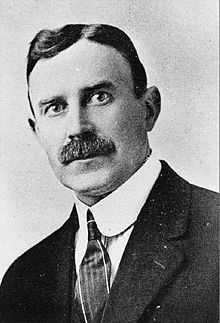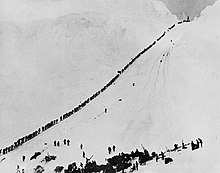Eric A. Hegg
Eric A. Hegg (also Eric A. Hägg , actually Erik Jonsson ; born September 17, 1867 in Bollnäs , Sweden ; died December 13, 1947 ) was a Swedish-American photographer who, with his photos of the Klondike gold rush became famous. Hegg himself took part in search expeditions with his brother and other Swedes, while documenting the everyday life and hardships of the gold diggers.
The best-known photo by Eric Heggs shows the Chilkoot Pass , which miners and gold prospectors climb over ice steps towards the Canada-US border. Eric A. Hegg is the subject of books and films as the embodiment of the American Dream , as he was able to leave his humble circumstances in Sweden behind and became a self-made man and successful photographer.
Youth and education
Eric Hegg was born as the second eldest son of the Büdner Jon Persson and Brita Ersdotter. He had two younger brothers and two younger sisters. Because the family was repeatedly displaced to ever smaller plots deeper and deeper into the forest, the entire family emigrated to the United States in April 1881. Upon arriving in New York City , the family gave up their Swedish surnames and took the name Hegg. Hegg is derived from Heggesta, the Swedish landscape from which they came. The family settled in the Swedish settlements on the south coast of Lake Superior in Wisconsin . Fourteen-year-old Eric Hegg trained as a photographer in Cloquet, Minnesota and later opened his own photo studio in Washburn, Wisconsin .
In 1888, Eric Hegg settled in the Swedish community outside of Bellingham, Washington and opened a new studio with his brother Peter. After photographing forest workers and farmers in the region for a few years, the town was hit by the gold rush . Another Swedish American had returned rich from the Klondike gold rush . This led to a wave of young men migrating to Alaska and northwestern Canada. The Hegg brothers followed their lead to open up new areas for their photography business.
Klondike gold rush
In October 1897, Hegg arrived in Skagway after a brief stop in Dyea . He immediately opened a studio in town. A year later he was joined by his brother and a friend of the two brothers, Peter Andersson. The following spring, Per Edvard Larss, another Swedish American, joined them.
The newcomers did some expeditions along the Chilkoot Trail and further north and west to Dawson and Yukon via Bennett , taking lots of photos. Hegg built a darkroom on the boat he used to ride along the Klondike . The Hegg brothers and their business partners opened studios in Dawson and sold portraits to the border residents, but also claimed land and mined.
After a year in Yukon, Hegg returned to Skagway in 1899, leaving his Dawson studio to his business partner Larss and another famous Klondike photographer, DuClos. Hegg traveled to New York that same year to display his paintings in a gallery, while his brother returned to Bellingham to run their old studio. When he returned to Alaska, Eric Hegg traveled to Nome to visit other Swedes who worked in the area and took pictures of community life and the city. Among his customers were the "three lucky Swedes" who were the first to get rich in Nome through mining. Hegg took her portraits and opened his largest studio to date.
His nomadic lifestyle had consequences and his relationship with his wife Ella was strained. In 1902 the marriage ended in a bitter divorce and the Skagway studio went to his wife, who sold it with all of the photo negatives. Since the stamps were removed from the buyers, many of the later Alaska photos are difficult to assign to Hegg. Before leaving Alaska to live in Hawaii for a brief period, Hegg lived in Cordova and Nome, where he worked for Guggenheim's Copper River and Northwestern Railroad until 1918 .
Next life
Hegg returned to Bellingham, Washington to live with his son and reunited with his brother to work in their old studio. But their partnership didn't last long. While his brother turned to agriculture, Eric Hegg kept the business going until 1946.
estate
His work was collected by the daughter of his friend from Skagway, Peter Andersson, and later given to the archives of the University of Washington .
The 1957 National Film Board of Canada documentation City of Gold used many photos of the Hegg Gold Rush from the archives of the University of Washington.
Photo gallery
Individual evidence
- ↑ John Hannavy: Encyclopedia of Nineteenth-Century Photography . Routledge, New York 2013, ISBN 978-0-415-97235-2 , pp. 1368 (English).
- ^ A b Elinor Barr: Swedes in Canada: Invisible Immigrants . University of Toronto Press, Toronto 2015, ISBN 978-1-4426-1374-4 , pp. 419 (English).
- ↑ Details on Eric Hegg, "California Death Index, 1940-1997". In: familysearch.org. Accessed December 4, 2017 .
- ^ Murray Morgan: Nor Rapids, Nor Mountains, Nor Brothels Stayed Him . In: The Independent . Long Beach Aug 3, 1967, p. 23 (English, newspapers.com ).
- ↑ a b c d e f The Dream of America - "Guldgrävarfotografen Eric Hegg (The Gold Digger Photographer Eric Hegg)", TV series by Per Eric Nordquist, 1996
- ↑ a b c d Eric A. Hegg Photographs. In: University of Washington Digital Collections. Accessed December 4, 2017 .
- ^ Gary Evans: In the national interest: a chronicle of the National Film Board of Canada from 1949 to 1989 , Repr. Edition, University of Toronto Press, Toronto 1991, ISBN 0802068332 , p. 75 (accessed August 16, 2016).
| personal data | |
|---|---|
| SURNAME | Hegg, Eric A. |
| ALTERNATIVE NAMES | Eric A. Hagg; Erik Jonsson (real name) |
| BRIEF DESCRIPTION | Swedish-American photographer |
| DATE OF BIRTH | September 17, 1867 |
| PLACE OF BIRTH | Bollnäs , Sweden |
| DATE OF DEATH | December 13, 1947 |









